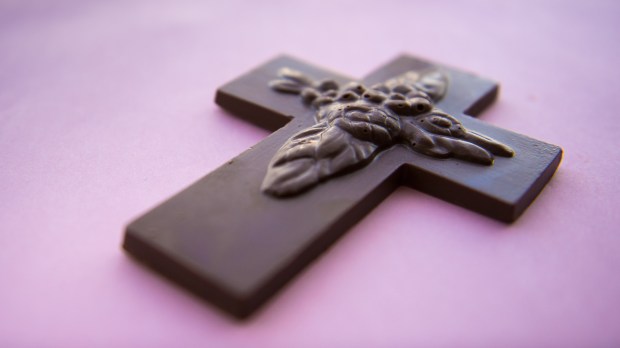While searching for allergen-free Easter basket goodies, I stumbled across an old article arguing that chocolate crosses cross the line. Where I had been thrilled to find not only dairy-free bunnies and corn-free jelly beans but also dark chocolate crosses that my child could eat, apparently some Christians find them disturbing and even blasphemous. It seems to me that they’d forgotten how to see those treats with the eyes of a child.
I like to tuck a chocolate cross into the kids’ baskets on Easter morning; the cross among the eggs and chicks reminds them what this day means: Resurrection, triumph over the grave, new life in Christ. I have photos of all of my children over the years with chocolate-smeared faces nibbling the arms off their crosses, and while our allergy-sufferer is amazingly okay about having separate but equal treats, I really wanted to get her something special this year.
But not everyone shares my thrill at finding chocolate crosses. I guess I’m not surprised that they’re offensive to some Christians. There are people who will take offense at almost everything. But I was more than a little surprised that the article quoted the spokesman for a Roman Catholic diocese:
“The cross should be venerated, not eaten, nor tossed casually in an Easter basket beside the jelly beans and marshmallow Peeps,” he said. “It’s insulting.”
I wonder if he’d also find cross-shaped Easter breads insulting, or lamb-shaped cakes? There’s a long tradition in many cultures of forming food into crosses, not to venerate as we do with the crucifix at the liturgy of the Lord’s Passion but to act as a reminder, a symbol even to be included (and consumed) in our celebrations. Think of Italian St. Joseph altars with all the various shaped foods: Hammer and nail bread, cross cakes, pretzel and chocolate crowns of thorns, shepherd-hook bread, monstrance-shaped breads. Think of Polish Oplatki Christmas wafers with images of the Nativity on them that, according to tradition, “deliberately shadow the Eucharistic meal that Catholics participate in at each Mass.”
I thought about my friend Rebecca’s beautiful Bread of Easter Brightness. Spiced with exotic flavors, mastic and mahleb, braided into the shape of a cross and adorned with five red-dyed eggs, it is a joyful celebration of the resurrection, a delight for the senses. It is her son’s first, strongest association with the holiday and, as she says, the most fundamentally right thing they do. It is an anchor for their celebration of the feast in their domestic church.
And again, I think of my children on Good Friday, eating hot cross buns, each painted with a white cross, and each of them coloring a picture of the crucifixion. The toddler is there too, scribbling across Jesus’ face with black crayon. Is she desecrating the cross? Is she blaspheming? And am I enabling it by feeding them food marked with a cross and letting them scribble on a picture of the cross?
What about when they carry about cheap plastic rosaries that they break to pieces? What about the three crucifixes that have been casualties of small children, broken in half, but still carried about and treasured? Are these images being profaned by this attention? Or does what they gain in the experience offset the damage? Small children can be terrible consumers. They break and devour the world in their eagerness to explore. They learn by doing, by tasting and smelling and touching and playing and, yes, sometimes by breaking.
And so I don’t just toss the cross in casually in an insulting way. It’s carefully chosen, lovingly sought after. The centerpiece: Here, child, hold the cross. Here, take and eat. Isn’t it sweet?
Why do you have a cross in your basket? I ask a small child.
“Because Jesus died on the cross?”
And what happened after that?
“He was buried in the tomb.”
And then?
“He rose from the dead! And that’s Easter!”
Our faith is incarnational. Our God makes himself manifest. He comes to us under the appearance of bread and wine and demands that we gnaw on his flesh, drink his blood. These little ones are too young to partake in the Eucharistic feast, but they can begin to understand the symbolism remotely with these lesser feasts of spiced bread and chocolate crosses. And a careful mother can sneak in a little catechism lesson while they munch on their goodies.
Taste and see the goodness of the Lord, little one. Eat this cross, you who are too small to eat the one who died on the cross. Taste and see that the Lord is good.
When Bella, our oldest, was just a toddler, I used to pray Morning Prayer aloud while she played nearby, seemingly oblivious to my devotions. Occasionally as I was praying she began to repeat some of the words, usually the antiphons. One of my favorite antiphons is, “See how the cross of the Lord stands revealed as the tree of life.” I was surprised and filled with joy to hear my two-year-old daughter lisping, “The cross is the tree of life. Tree of Life.”
On Good Friday the deacon will elevate the cross and chant, “Behold, the wood of the cross,” and then I will lead my children up and some of them might even kiss the wood. On Easter Sunday they will again touch a cross, and they will definitely eat it. This is how children learn; they touch, they smell, they taste, they move, they do.
“We adore you, O Christ, and we bless you because by your Holy Cross you have redeemed the world.”
Melanie Bettinelli is a mother of five who home schools her children in the suburbs of Boston. She blogs about books, poetry, faith, art, food and education at The Wine Dark Sea.

